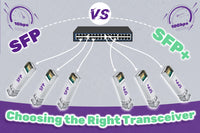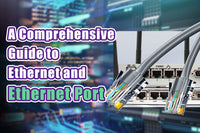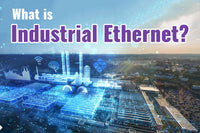Contents
InfiniBand and Ethernet are prominent network communication technologies in today’s rapidly evolving network. Ethernet has been a standard technology for most network needs, providing efficient and reliable performance. However, InfiniBand has emerged as a high-performance option for data-intensive networks. The choice between InfiniBand or Ethernet for your data center can greatly impact network speed and performance. This blog will dive into the benefits of both InfiniBand and standard Ethernet to help you make the right choice for your data center.
What is Ethernet?
Ethernet, introduced commercially in the 1980s, has become the dominant communication protocol for Local Area Networks (LANs). Ethernet is designed to transmit data between different systems by protocols like TCP/IP and RoCE (RDMA over Converged Ethernet), allowing devices within the same network to communicate and exchange information efficiently. There are different types of Ethernet, including Fast Ethernet, Gigabit Ethernet, and 10 Gigabit Ethernet.
Different devices within a LAN, like printers and computers, can communicate with each other via coaxial cables, twisted pair cables, faster fiber optic cables, and wireless technology. There are different categories of twisted pair cables, including Cat5e, Cat6, Cat6a, and Cat8 cables. These cables support different network speeds and bandwidth, e.g., Cat6a cables can support the maximum data rate of 10 Gbps.

What is InfiniBand?
InfiniBand was developed in 1999 by Future I/O and Next Generation I/O (NGIO). It is an open standard network interconnection technology that provides high bandwidth and low latency for supercomputer clusters. It is specifically designed for fast and efficient data transfer and process, including high-performance computing (HPC) environments, including GPU servers. InifiBand supports remote direct memory access (RDMA) technology to directly access the memory of two computers for efficient data transmission. It also supports virtualization, security, and QoS features.
The InfiniBand networks support single-data rate (SDR) signal at a rate of 2.5Gbits/sec per lane, double-data rate (DDR) at a rate of 5Gbits/sec per lane, and quad-data rate (QDR) at a rate of 10Gbits/sec per lane. And NDR and XDR can even achieve the data rate of 400 Gb/s and 800 Gbps separately.
InfiniBand uses a switched fabric topology that allows different network nodes to interconnect in a single network structure, making it easy to scale up and communicate with more devices. Data can be transmitted between servers or between servers and storage without the need for the host CPU, reducing the possibility of CPU overloads.

How Does InfiniBand Work?
InfiniBand uses InfiniBand Architecture (IBA) stack layers that define the point-to-point switching. It adopts fabric topology, allowing for high-speed data communication between interconnected nodes. InfiniBand transmits data through packets over different lanes and each lane can support different data rates ranging from 2.5 Gbps to 400 Gbps based on different versions. Receiving and sending data requires a host channel adapter (HCA) and a destination channel adapter (TCA). HCA is used to interconnect between the host system and the InfiniBand network; TCA is used for remote storage and network connectivity.
The InfiniBand architecture (IBA) mainly consist of five layers, including Upper Layer, Transport Layer, Network Layer, Link Layer, and Physical Layer.
The upper layer protocols consist of MPI (Message Passing Interface), NCCL (NVIDIA Collective Communication Library), RDMA Storage Protocols, and IP over InfiniBand. These protocols provide interfaces for applications to access message services.
The transport layer provides transport services based on the sending hardware and receiving hardware. The message is transmitted from the sending application to the receiving application’s buffer.
The network layer allows network devices to route packets between different InfiniBand subnets by providing global ID or GID addresses.
The link layer is responsible for matching the source and destination local IDs (LIDs) on network switches. According to the flow control protocol, the flow control mechanism is used to control the transmission rate. Once the receiving buffer space is free, the sending node can send data.
The physical layer defines the signaling protocol of the constitution of a valid packet and the characteristics and specifications for InfiniBand AOC and DAC cables.
6 Differences between InfiniBand and Ethernet
With the rapid development of central processing unit (CPU) computing and high-speed networking for supercomputers, InfiniBand has become an increasingly critical network technology. But what are the key differences between InfiniBand and Ethernet? They can be compared across the following six main aspects:
- Architecture: Ethernet network is based on a traditional broadcast and point-to-point architecture, which means that each device within the network relies on packet packet broadcasting.While InfiniBand uses a switch fabric topology, meaning that all devices are designed to communicate with each other via switches and use multiple links to transmit data.
- Speed and Latency: Ethernet andInfiniBand have significant differences in terms of data rate, bandwidth, and latency. The latest InfiniBand has a higher bandwidth than Ethernet. In addition, using bandwidth efficiently is very important for high speed communication between different devices. The RDMA technology solves the problem of CPU offloading, which allows fast network processing in InfiniBand. In terms of latency, Ethernet switches usually use MAC addressing and require longer processing time due to the need of IP, MPLS, and QinQ services. In contrast, InfiniBand switches are simple to process data at network layer 2. So, InfiniBand has a lower latency than Ethernet.
- Network Scalability: What about the scalability of both Ethernet and InfiniBand? It depends on different use cases. InfiniBand may seem like a better choice for handling massive data, but in terms of general uses, Ethernet has a higher scalability than InfiniBand. Ethernet is compatible with the existing data center infrastructure and its wide adoption makes it highly flexible and scalable. As for InfiniBand, it requires complex and specific network configurations and specific hardware and software, which make it less accessible for general scalability.
- Security: They both provide encryption, authentication, access control, and network segmentation features, but there are some distinctions. InifniBand encrypts data from end to end using Secure Sockets Layer (SSL) and Transport Layer Security (TLS) protocols; and uses unique identifiers (UIDs) for authentication, but Ethernet uses IPsec (Internet Protocol Security) for encryption and authentication. Compared to Ethernet, InfiniBand provides robust access control lists (ACLs) to restrict access; and segments the network into separate secure virtual networks. InfiniBand also provides more advanced security features, like Secure Key Exchange and Secure Data Integrity. InfiniBand does not offer wider security features compared to Ethernet, it uses channel adapters to exchange information to ensure security.
- Cost: Ethernet is more cost-effective than InfiniBand with its easier deployment, maintenance, and easy-to-get hardware and software. In contrast, InfiniBand has a limited ecosystem, with only one supplier Mellanox (acquired by Nvidia). It requires specific IB network cards and switches.
- Distance Limitations: Generally, InfiniBand links can not extend longer than Ethernet. The permanent link of Ethernet is limited to 295 feet or 89 m at 68 degrees F, while InfiniBand is limited to only a few meters on Copper InfiniBand (Cu-IB) cables and a few meters to several kilometers on Fiber InfiniBand (F-IB) cables.
InfiniBand vs. Ethernet: Which to Choose?
Data centers are huge computer rooms that provide data storage, management, and computing. They are important facilities for large enterprises or other organizations. Choosing between Ethernet and InfiniBand networks has a big impact on your data center performance.
Ethernet can be the best choice for most general-purpose networks with its easy deployment, backward compatibility, cost-effectiveness, flexibility, and ease of integration. You can choose Ethernet for common networking like enterprise networks, LANs, and cloud infrastructure.
InfiniBand is more suitable for data-intensive environments where high speed, low latency, and reliability are big concerns. It is the best choice for supercomputing, real-time analytics, AI model training, and data centers for large workload processing. But there are some factors that you should consider for deploying InfiniBand. InfiniBand comes with high management costs and limited availability, making it less practical and feasible for organizations to upgrade from Ethernet architecture.
In Summary
Ethernet and InfiniBand offer unique advantages for specific network applications. Ethernet is known for its wide compatibility and flexibility, while InfiniBand provides superior speed and bandwidth for data-intensive networks. Whether you choose Ethernet or InfiniBand, you should understand their differences before making a decision that best suits your specific needs.
For more information on this topic, you can keep up on our blogs. While VCELINK offers general and basic information for our customers and other visitors to the website, it’s not professional advice.



Be the first one to comment.
Leave a comment